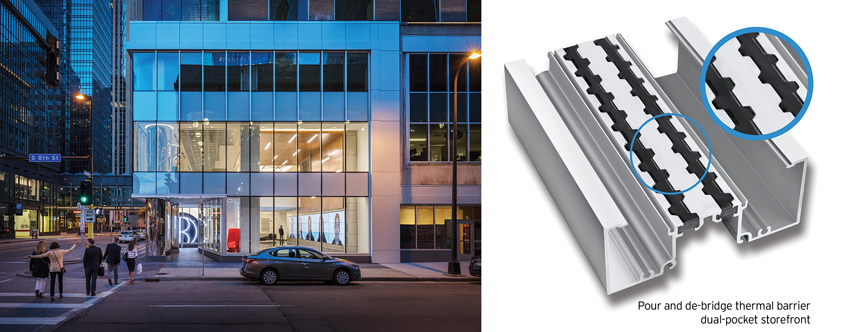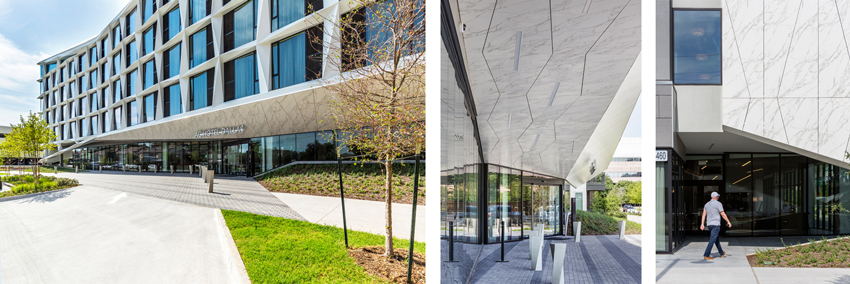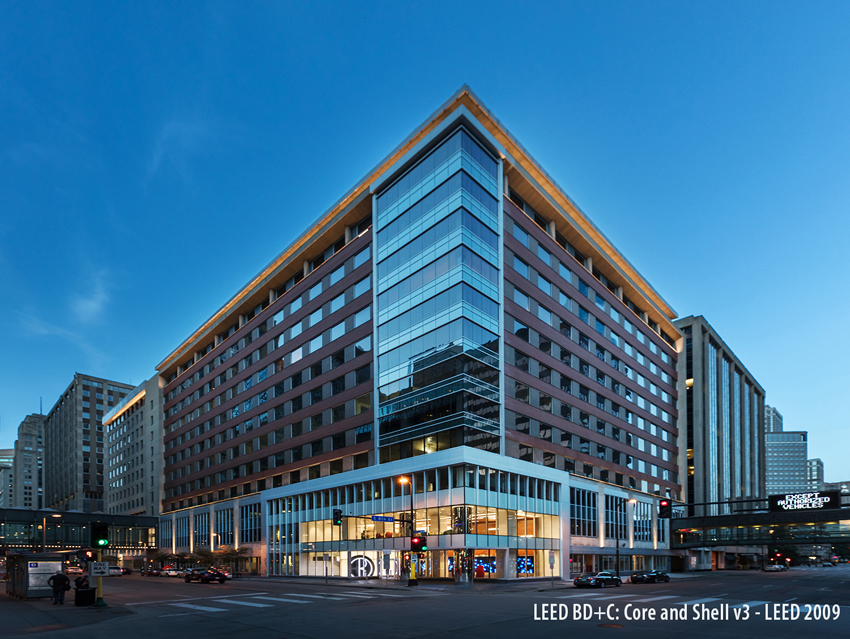Creating High-Performance Building Facades
Energy-Conserving Fenestration Systems
Fenestration usually figures prominently in most building facades. This can include windows, doors, louvres, vents, wall panels, skylights, storefronts, curtain walls, and sloped glazed systems. For any of these systems to be installed in a building facade, they need to have a manufactured frame to hold them in place and secure them to the rest of the building. In most commercial buildings, the material of choice is usually an aluminum frame or support system of various types. The reasons for its use are based on its lightweight but inherently strong nature as a material, its ability to avoid rust or corrosion, its rather economical workability, and the variety of colors and finishes in which it is available. However, it is also an excellent conductor of heat, which makes its use on building facades a concern when addressing energy-conserving design and compliance with energy codes, as the aluminum acts as a thermal bridge between inside and outside. This is true in both cold and warm climates as well as extreme weather conditions.
Manufacturers of aluminum framing systems for fenestration have been addressing the thermal issue for decades and continue to develop products that maintain their structural integrity while offering improved thermal performance. The key component is the addition of a thermal break or barrier in the aluminum frames, usually in line with the location of glass or other glazing in the frame. The intent is that the interior and exterior portions of the frame are separated with a structurally rigid but less thermally conductive material. The details of how that break is created and the choice of materials used are what tend to differentiate various products from each other.
Commonly, there are three choices of material used as thermal breaks or barrier material in commercial fenestration systems: vinyl plastic, polyamide nylon, and polyurethane polymer. Each has different thermal and structural properties, so finding the best choice is a combination of understanding these properties and the way they work with the details of a particular aluminum frame profile. This relationship is what manufacturers work on improving and perfecting to provide products that are reliable, economical, and functional.

Photo: © Paul Cosby Architectural Photography; Image: © Tubelite Inc.
The aluminum framing used in fenestration systems include tested and proven thermal breaks or barriers to improve thermal performance while maintaining structural integrity and overall performance.
Of late, polyurethane has received a good bit of attention as a thermal-barrier material in aluminum frames since it can provide superior thermal performance to other choices. For example, using standard test procedures based on the National Fenestration Rating Council (NFRC) 101, U-factors of frames with different thermal-barrier materials can be determined. In a comparison of thermal conductivity of materials according to ASTM C518 standard test method, polyamide 6.6 with 25 percent glass fiber showed a thermal conductivity of 2.08. By contrast, a vinyl barrier produced a better (i.e., lower) result at 1.18, while polyurethane performed the best at 0.84. The significance of the differences in performance, as it relates to the design of the aluminum frame, is that a lower-conducting material will not need as wide a gap to achieve a targeted thermal performance. For example, in at least one frame comparison, a polyamide thermal barrier was used to achieve a U-factor of 0.39 but required a 24-millimeter gap to do so. By contrast, a polyurethane barrier was used to also achieve a U-factor of 0.39 but only required a 15.8-millimeter gap. A smaller gap can mean better structural performance of the frame and possibly thinner overall profiles of products. Hence, achieving better thermal performance in thinner breaks has advantages when seeking to create better fenestration products that allow better sightlines, more structural integrity, and durability.
The most proven approach to effectively install the thermal-barrier material that isolates the inner and outer frames is referred to as a “pour and de-bridge” process. This is based on first creating an extruded aluminum profile that has been designed with a strategically placed channel in the middle of the frame piece. This channel is typically U-shaped and open to the top to receive the thermal-barrier material. Once ready, the thermal-barrier material is installed using specialized equipment designed for this purpose. If polyurethane is used, then it is literally poured in liquid form into the predesigned channel. Then, within minutes, polyurethane solidifies into a very strong structural polymer. The final step in the process cuts and removes the metal thermal bridge from the bottom of the channel to produce a true, non-metal-to-metal structural thermal barrier. This pour and de-bridge method is suitable for withstanding demanding climates and conditions with high-performance requirements in terms of impact resistance, shear strength, and heat distortion.
Remarking on the capabilities of such systems, Mary Avery, vice president of marketing at Tubelite, explains, “In colder climates, this type of system provides superior energy results and condensation resistance using multiple thermal barriers, while providing structural integrity and aesthetic flexibility.” She continues, “Optimizing thermal performance helps lower the load on HVAC systems and reduces associated energy costs, while maintaining a comfortable interior temperature.” She also notes that the reduction of condensation can improve a building’s appearance and minimize moisture damage to adjacent building materials.
Notice

www.azonintl.com

www.hofmann-facades.com

www.inpro.com

www.neolith.com

www.vitroglazings.com











